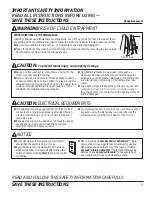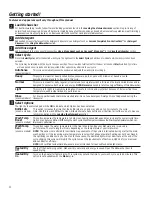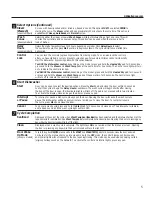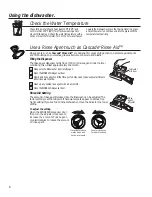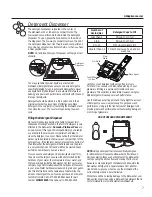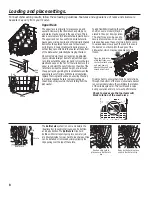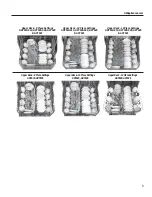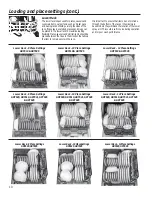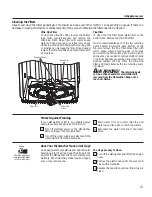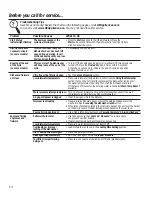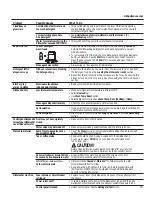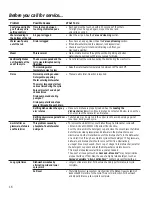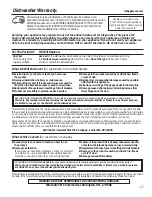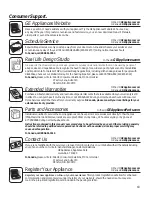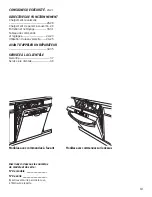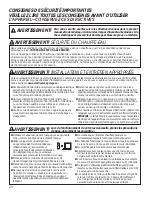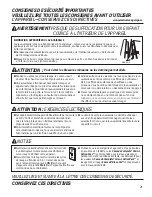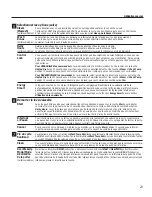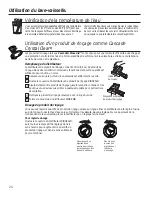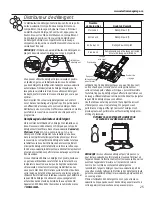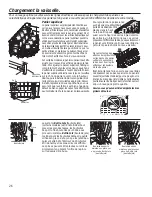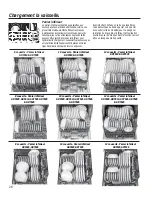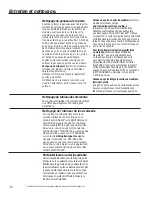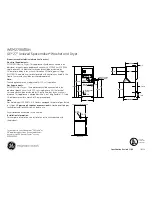
Problem
Possible Causes
What To Do
Cloudiness on
Combination of soft water and • This is called etching and is permanent. To prevent this from happening,
glassware
too much detergent
use less detergent if you have soft water. Wash glassware in the shortest
cycle that will get it clean.
Low performing phosphate
• See A white film on glassware, dishware and the interior in this
free detergent
Troubleshooting section.
Water temperature entering the • This could be etching. Lower the water heater temperature.
dishwasher exceeds 150°F (66°C)
Suds in the tub
Correct detergent
• Use only automatic dishwasher detergents to avoid sudsing. Cascade
®
wasn’t used
Automatic Dishwashing Detergents have been approved for use in all
GE dishwashers.
• To remove suds from the tub, open the dishwasher and let suds dissipate.
Pump out water by pressing Start and close the door. Wait 30 seconds.
Open the door, press and hold Start for 3 seconds, and close the door.
Repeat if necessary.
Rinse agent was spilled
• Always wipe up rinse agent spills immediately.
Detergent left in
Dishes or utensils are blocking • Reposition the dishes, so the water from the lower spray arm can flush
dispenser cups
the detergent cup
the detergent cup. See the Loading the dishwasher racks section.
• Reposition the tall utensils or heavy silverware that may be keeping the
dispenser cup door from opening. See the Loading the silverware basket
section.
Black or gray
Aluminum utensils have
• Remove marks with a mild, abrasive cleaner.
marks on dishes
rubbed against dishes
Dishes don’t dry
Low inlet water temperature
• Make sure inlet water temperature is at least 120°F.
•
Select
Heated Dry.
•
Use
Wash Temp Boost option.
• Select a higher cycle, such as Wash Temp Sani (Sanitize) or Heavy.
Rinse agent dispenser is empty
• Check the rinse agent dispenser and fill as required.
Cycle selection
• If using Light Cycle which uses lower water temperature and thus limited dry
performance, switch to a different cycle.
Cycle completion
• Allow cycles to fully complete. See Long Cycle Times in this Troubleshooting
section
Control panel responded Door may not be completely
• Make sure the door is firmly closed.
to inputs but dishwasher closed
never filled with water
Water valve may be turned off
• Make sure water valve (usually located under the sink) is turned on.
Stained tub interior
Some tomato-based foods can
• Use of the Steam cycle (on some models) after adding the dish to the load
cause reddish stains
can decrease the level of staining.
Tea or coffee stains
• Remove the stain by hand, using a solution of 1/2 cup bleach and
3 cups warm water. NOTE: Do not use bleach on stainless steel
tub or inner door.
CAUTION!
Before cleaning interior, wait at least 20 minutes after a cycle for the
heating elements to cool down. Failure to do so can result in burns.
An overall yellow or brown film can • A special filter in the water supply line is the only way to correct
be caused by iron deposits in water this problem. Contact a water softener company.
:KLWHILOPRQLQVLGHVXUIDFH³ •
GE
recommends
Cascade
®
Rinse Aid™ to help prevent hard water
hard water minerals
mineral deposits from forming.
• Run dishwasher with citric acid to remove mineral deposits. Citric acid
(Part number: WD35X151) can be ordered through GE Parts. See back
cover for ordering information.
Dishwasher won’t run Fuse is blown or circuit breaker • Replace fuse or reset circuit breaker. Remove any other appliances from
is tripped
the
circuit.
Power is turned off
• In some installations, the power to the dishwasher is provided through a
wall switch, often located next to the disposer switch. Make sure it is on.
Control panel is locked
• Unlock control panel. See the Getting started section.
15
GEAppliances.com
Содержание ADT521 Series
Страница 36: ...36 Notes ...



